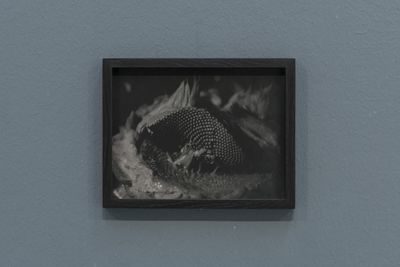Man RayArtichoke (1930)Photography17.4 x 22.8cmReproduction of silver gelatine photography
On a spring night in 1898, Sigmund Freud dreams another dream:
“I had written a monograph on a certain plant. The book lay before me and I was at that moment turning over a folded coloured plate. Bound up in each copy there was a dried specimen of the plant, as though it had been taken from a herbarium.”
Freud names it the Dream of the Botanical Monograph and – staying faithful to his own analytical habitus – he follows the topoi of his dream-tableau through tunnels of swirling associations filled with cyclamens, forgotten birthday bouquets, doses of cocaine, anaesthesia, and a certain Dr Königstein. And the connection to Man Ray’s surreal (and strangely overlooked) photography of a transformed artichoke? It appears when Freud describes his childhood education in elementary botany and declares:
“I went on from the Cruciferae to the Compositae. It occurred to me that artichokes were Compositae, and indeed I might fairly have called them my favourite flowers. Being more generous than I am, my wife often brought me back these favourite flowers of mine from the market.”
Freud continues the discourse on his vegetable fetish as he, into this ever evolving fabric of images, weaves in another childhood scene in which a book is being pulled to pieces “leaf by leaf, like an artichoke.” The artichoke is the body that peals; it is language that germinates: herbarium as verbarium, playing the anagrams. Like the rest of the surrealists, Man Ray knew his Freud. Glistening with grease, halfway opened and gooey, obscene and in every way vulgarly enticing, the excrescence on the photography is taken directly from the suggestive line of dreams. Yet, even an expansive Freudianism will not suffice to unravel its pulp. The morphology of the artichoke also draws – bearing in mind, the botanical textbooks – on photographic plant studies. Shaped by a formal kinship with the photographic atlas of the life sciences in which plants, planets, and human skulls were being indexed in meticulously intricate grids. In the scientific atlas, as in the interpretation of dreams, the object is both relational and fetishized. The artichoke is hallucinating difference as well as its own highest potency. It is terribly appetising. Painfully ready to be served as something else. In the system of André Breton, the éminence grise of surrealism, Man Ray’s artichoke would be filed under beauté convulsive – flickering between stasis and explosive displacement: “Beauty will be convulsive or will not be at all.” This, apparently, also pertains to the highest order of gastronomy.
Emil Leth Meilvang
Biographies
Man Ray (born Emmanuel Radnitzky; August 27, 1890 – November 18, 1976), was an American visual artist.
Emil Leth Meilvang is a PhD candidate in Art History at the University of Oslo where he works on a project on the interpenetration of biology and modernist aesthetics.

